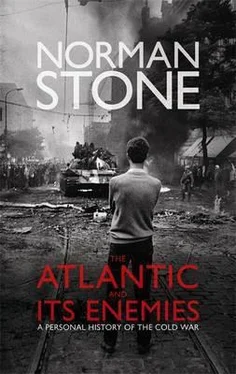At this stage, the Americans’ tactics were simple enough. As Sheehan rightly said, men of limited capacity, who knew their limits, would just go on doing what they knew they were good at; anything different would bewilder them. General William Westmoreland was one such. He replayed the Korean War. ‘Operation Rolling Thunder’ went ahead, with huge quantities of explosives dropped on what were known as ‘free zones’. Westmoreland gave press conferences at which he outlined the stages in which the war was supposed to come to an end — in this case, quite precisely, November 1968, while McNamara busied himself with his mathematics on the subject, and his deputy, Cyrus Vance, established an air-mobile cavalry division, with Huey gunships, firing rockets from side-pods. In November 1965 there were already battles of some scale with North Vietnamese regular soldiers who had come down the Ho Chi Minh Trail, and, given the patience and ingenuity with which these troops waited in ambush, with Soviet weaponry, the battles were testing for the Americans. Their firepower could reduce fishing villages to rubble but there was nothing they could do to prevent the Vietcong from reoccupying the rubble, and there were grotesque episodes in which tactics of attrition were used in rice paddies, complete with ‘Zippo jobs’ on thatched village huts that could be ignited with a flick of a cigarette lighter. There was not much, either, to be said for the use of herbicides (‘Agent Orange’) to destroy vegetation, and hence cover for the enemy. Immense areas of forest were destroyed every year — in the whole war, 12 million acres, together with 25 million of farmland. B52s, in waves of three apiece, would attack a ‘box’ of two miles’ length and 1,100 yards’ breadth, with huge bombs, dropped at will. The aircraft also never flew lower than 3,500 feet, and thus were unable to pinpoint their targets.
Even the army Chief of Staff complained how ‘indiscriminate’ had been ‘our use of fire-power… I think we sort of devastated the countryside. ’ By 1966, there had been 2 million refugees and Saigon itself rose in population from 1 million to 3 million — rubbish cities, impossible to patrol or govern, except through mafias, of which the Vietcong were obviously one (Samuel Huntington remarked that ‘in an absent-minded way the United States in Vietnam may well have stumbled upon the answer to wars of national liberation’ — i.e. clear out the peasants who were then thought to be their principal support). All in all, up to 1974, there were 1.16 million civilian war casualties, at least half of them by US action from the air. By the time of the January 1973 ceasefire, an area the size of Texas had received three times the bomb tonnage dropped on Europe in the Second World War (though the air force complained that it had been forbidden to touch essential targets — Hanoi itself, or the port of Haiphong, or the Red River dykes, the collapse of which would have destroyed the country).
The North Vietnamese put up an extraordinary effort. They faced an exceedingly difficult situation, in that their Soviet and Chinese patrons were at odds — the ‘Sino-Soviet split’ which had the two sides bombarding each other with insulting messages and at one stage even produced combat over a disputed border. The Vietcong inclined towards the Chinese, and from them acquired, in 1962, 90,000 rifles and machine-guns. There was a prodigy of effort involved in the Ho Chi Minh Trail which brought weaponry to the guerrilleros in the South. At first the trail had been primitive, but in 1964 a railroad was constructed: in 1964 10,000 soldiers had gone south every month, but by 1967, 20,000. The Trail became a very elaborate network, with tunnels and several branches; it supported 170,000 North Vietnamese troops in the South. The heart of the military problem, for the Americans, was that they had to move out in small groups, probing for a much larger Vietcong force that would withhold fire — in May 1968, at Hue, even with 500 Americans set against 20,000 Vietcong in difficult country. Besides, the weakness of their allies meant that Americans had even to do small-scale patrol work. Now, they also had to undertake what resembled a frontal war, as the North Vietnamese came in via the tunnels or through Cambodia. There were set-piece battles in the absurdly named DMZ (‘demilitarized zone’).
Giant bombing raids were astonishingly ineffective, against North Vietnamese troops that could continue with slender resources — a mere fifteen tons every day — and the entire electricity supply of North Vietnam was only a fifth of that in Alexandria, Virginia. The dockers in the North learned how to cope with the threat of bombs, and imports from China more than doubled between 1965 and 1967 (to 1.4 million tons): barrels of oil went by barge along the canal network. The attrition campaign in effect damaged the Americans more, in that they lost 700 aircraft by the end of 1967. The Americans compounded their own problems by sending draftees home after a year, which meant a constant influx of inexperienced and, in the end, very reluctant young men, and it was remarkable enough that they did not run amuck, as such soldiery could easily have done. Of course, they resented the local people (‘staring at us as if we were from Mars’, said one) and there was a celebrated incident in March 1968 when at a village called My Lai peasants were killed by American soldiers, enraged at the endless obstinacy and guile of the enemy. McNamara had been obsessed with his ‘bottom line’, in this case dead enemy. The corpses were supposed to be counted, so ambitious soldiers gave him them. There was even an absurd system for spotting concentrations of urine below in the jungle, and many peasants died therefrom. One consequence was what gave Huntington his preposterous looking-on-the-bright-side. There were 2 million refugees in the cities, especially Saigon, by 1967. The Hao Hoa sect-gang did a deal with the Vietcong in order to operate a black market in the products distributed under the aid programmes: tractors were simply bartered. Meanwhile in Saigon Westmoreland presented multicoloured charts for the press, some of which was beginning to adopt derision. He defended the tactics with an all-American metaphor: that the alternative was like using a screwdriver to kill termites: if you overdid it you brought the house down. It was all an invitation to revenge, even suicidal revenge. The Americans had scotched their snake, not killed it, and it bit back.
In the early hours of the morning of 31 January 1968 two ancient vehicles drove up to the American embassy compound, and nineteen men jumped out, to plant explosives in the wall. The guards shot back, but one of the Vietcong managed to reach the embassy building itself, and got in. The shooting went on all night, until, finally, one of the diplomats killed the infiltrator. The Vietcong had prepared very thoroughly — smuggling the explosives in rice lorries, and using, as agent, a chauffeur who had worked for the Americans for years. Nor was this the only attack: the radio station itself was seized by fourteen men who had been training for three months, and there were lesser troubles all over Saigon, the worst when the Vietcong broke into the house of the chief of police, shot him, and slit the throats of his wife and six children. Another police officer, who had been godfather to one of the children, caught one of the men, held a gun to his temple, and fired. The young man’s face, freezing at the very moment of death, made one of the most famous photographs of the war. The godfather’s reputation never recovered from this characteristic photographic lie (the photographer later ‘apologized’). These attacks and many more like them were called ‘the Tet offensive’, and it counted as a humiliation for the Americans. By then, opposition to the war had been building up inside the United States. It was based largely on conscripts’ unwillingness to go to a Vietnam the scenes of which were nightly shown on television. ‘Tet’ was the Vietnamese New Year, which began in February, and the American generals had previously been very optimistic: but for the Vietcong to be able to attack so widely, and to reach targets that were not only spectacular, but also happened to be within easy reach of television cameras, appeared to be a tremendous coup.
Читать дальше












![Edward Ellis - Adrift on the Pacific - A Boys [sic] Story of the Sea and its Perils](/books/753342/edward-ellis-adrift-on-the-pacific-a-boys-sic-s-thumb.webp)